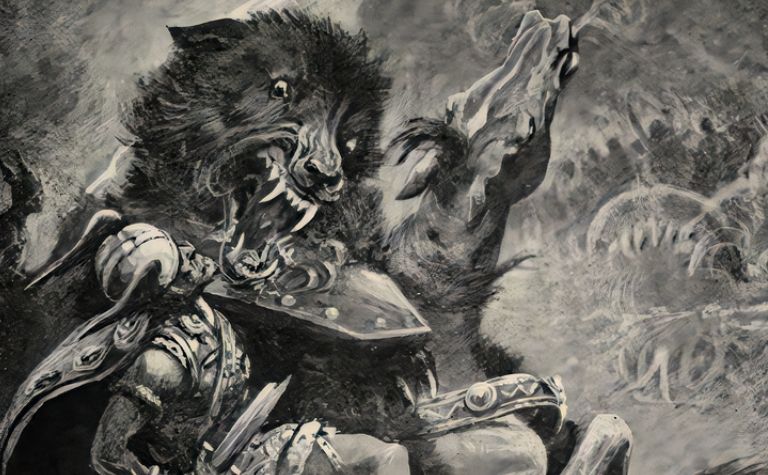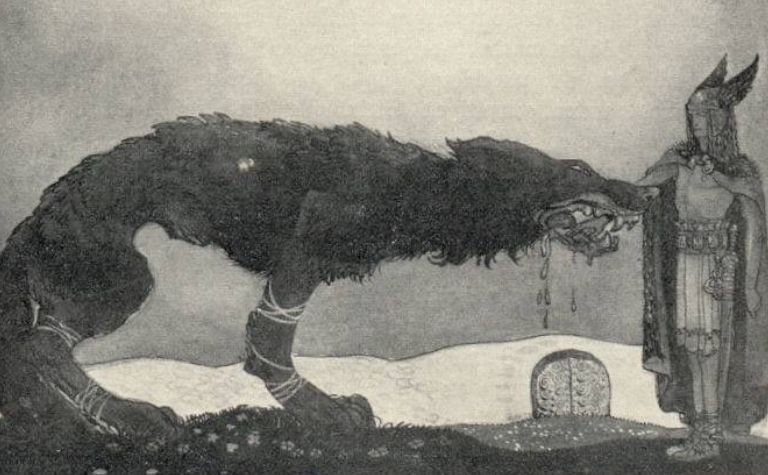When most people think of Norse mythology, their minds conjure Chris Hemsworth’s Thor, Tom Hiddleston’s Loki, and maybe Anthony Hopkins’ Odin.
However, there is so much more to Norse mythology than what made it into Marvel’s movies. For instance, they briefly introduce Fenrir in Thor: Ragnarok, but they barely touch on his story.
Fenrir, or Fenris Wolf, is the giant wolf son of Loki and the giantess Angrboda. He’s the brother of Jormungandr, the World Serpent, and Hel, goddess of the dead.
Fearing his power, the Aesir chained him in a cave, and according to Norse legend, he’s still there, awaiting Ragnarok and his freedom.
This article will shed more light on the powerful and ferocious Fenrir, why the gods feared him, how they tricked him into being bound, and who is destined to kill him in the battle of Ragnarok.
Also, see Can Ragnarok Be Stopped? to learn more.

What Is Fenrir the God Of?
Technically, Fenrir isn’t a god; he’s a giant wolf known for his incredible strength, for biting off Tyr’s hand, and for the part he’ll play in Ragnarok.
He’s Loki’s son, and the Aesir (and the people who believed in them) feared him, but he was never worshiped or sacrificed to like the gods were.
Just because Fenrir wasn’t a god didn’t mean that he wasn’t famous or that people didn’t tell stories about him.
There were stories about Fenrir in the Eddas, and it’s likely that these same stories – and perhaps even more – were told about him orally throughout the years.
One of the most famous stories concerning Fenrir is colloquially called “The Binding of Fenrir.” [1]
Also, see Did Loki Have Horns in Norse Mythology? to learn more.
The Binding of Fenrir
As the story goes, the gods, seeing that Fenrir grew larger every day and knowing that he was prophesied to kill Odin and do great harm to them in the final battle, decided to bind him and throw him in a cave under the earth.
However, Fenrir’s strength was so incredible that they knew they’d never bind him by force.
Instead, they goaded him into letting them put the chains on him by telling him that if he could break the strongest chains ever forged, his name would be legendary.
Fenris broke the first chain, called Lading, quickly, so the gods came back with a second, Drome, and he shook that one off like it was nothing, as well.
Finally, they asked the dwarves to make a fetter so strong that Fenrir would never be able to break it.
Also, see What Is Valhalla in Norse Mythology? to learn more.
Gleipnir
This “chain,” called Gleipnir, was nothing more than a thin, dainty ribbon, but the dwarves made it with six things that “didn’t exist”:
- The footfalls of cats
- The beard of a woman
- The roots of a mountain
- The sinews of a bear
- The breath of a fish
- The spittle of birds
It was the strongest chain ever forged, and the gods once again teased and taunted Fenrir into letting them bind him with it.
However, sensing a trick, Fenrir only agreed to be bound if one of the gods would place their hand in his mouth as a show of good faith that they weren’t trying to deceive him.
Tyr volunteered, and once they bound Fenrir and would not let him go, Fenrir bit down on Tyr’s hand and swallowed it whole, leaving him as “the one-handed god.”

Is Fenrir Good or Bad?
Fenrir was neither good nor bad. More accurately, he had both good and evil inside him, just like all the other prominent characters in Norse mythology.
Until the day the gods tricked him and bound him in a cave with a sword in his mouth, he had never hurt anyone.
The gods chained Fenrir and locked him away, not because he’d done anything to merit the punishment but because they’d heard a prophecy saying that he’d eventually be deadly and destructive and would kill Odin.
However, had the gods trusted Fenrir and allowed him to grow up in Asgard and live as a free creature, he may not have ever had a reason to harm them.
Perhaps the only reason he will break free at Ragnarok and kill Odin is because of the way the gods treat him.
Today, literary scholars and internet sleuths alike love to debate the self-fulfilling prophecy of Fenris Wolf.
Also, see What Is Valhalla in Norse Mythology? to learn more.
Fenrir and Tyr
There’s actually substantial evidence in the myths to support the idea that Fenrir would’ve been “good” if left alone.
He lived in Asgard and had a cordial relationship with the god Tyr, who brought him food every day.
In more recent retellings of the Norse myths, such as Neil Gaiman’s Norse Mythology, the two are even friends and companions. In his book, Gaiman writes:
“[Fenrir] had been puppy-sized, and Tyr had scratched its neck and played with it, removing its willow muzzle first. It was a wolf cub, gray and black, with eyes the color of dark amber. […] One day it was the size of a wolf, the next the size of a cave bear, then the size of a great elk. The gods were intimidated by it, all except Tyr. He still played with it and romped with it, and he alone fed the wolf its meat each day.”
Because of their bond, Fenrir trusted Tyr, and when Tyr volunteered to put his hand in Fenrir’s mouth, Fenrir believed that the gods were sincere and not trying to trick him.
That betrayal could be the thing that caused Fenrir to “become bad” in the end.
Also, see Greek Gods vs. Norse Gods: Similarities and Differences to learn more.
Who Killed Fenrir?
When Ragnarok happens, Odin’s son Vidar kills Fenrir as revenge for the wolf devouring his father. However, according to Norse beliefs, Fenrir is currently still alive, bound, and waiting for Ragnarok.
There are two versions of Fenrir’s prophesied death, although both say Vidar will be the one to kill him. In Voluspa, Vidar stabs his sword into Fenrir’s heart, killing him almost instantly.
However, in Snorri Sturluson’s The Prose Edda, Sturluson says that Vidar placed his powerful shoe (the most powerful shoe in the universe) on Fenrir’s lower jaw, then grabbed his upper jaw with his hand and ripped his head apart.
Final Thoughts
Of all the creatures in Norse mythology, Fenrir is one of the most fascinating because Ragnarok might’ve been very different had he never been mistreated.
